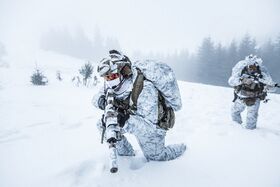Operation Anicetus (DW): Difference between revisions
(Created page with "{{Infobox military conflict | name = Seleucid Invasion of the Erebonian Empire | image = 280px | caption = Erebonian and Rubrumian troops in the...") |
No edit summary |
||
| Line 5: | Line 5: | ||
| date = 12 September 2042 - 25 December 2042 | | date = 12 September 2042 - 25 December 2042 | ||
| place = [[Erebonian Empire]] | | place = [[Erebonian Empire]] | ||
| result = Allied Victory | | result = Allied Victory<br/> Seleucid Failure<br/> | ||
* Allied | * [[Allied Winter Counteroffensive of 2042]] | ||
| combatant1 = | | combatant1 = | ||
{{plainlist| | {{plainlist| | ||
Revision as of 15:44, 17 March 2021
The Operation Anicetus (12 September 2042 - 25 December 2042) was the codename for the Seleucid invasion of the Erebonian Empire, which started on 12 September 2042 during the Deseleni War. The operation put into action the Resurrected Seleucid Empire's ideological goal of creating a world empire, and subjugating the entirety of the world under its control, as well as repopulating the world with pure-blooded Seleucids. The plan was aimed to use Erebonia's landmass to support an invasion of the Lucis Isles and conquering Alteria's oil reserves. Their ultimate goal included the eventual extermination, enslavement, Seleucidisation, and mass deporations to create more living space for the empire.
Despite the awareness of the Seleucids of the well known Erebonian Winter, the Seleucids expected Erebonia to fall before autumn. However, Erebonia's heavy forestry, as well as mountainous and rocky terrain favoured the Allies. Despite his age, Field Marshal Kiriya Kitagawa opted that the Allies must conduct a combination of Guerilla tactics and regular infantry attacks and raids to slow the Seleucids in time for the Winter. The Seleucids were shocked that Erebonian resistance to invaders was high. The Erebonians adapted well into the thick forestation of their land. Painfully slowing the Seleucids. Despite it, the Seleucids continued to push. Seleucids would arrive by the outskirts of the capital, Heimdallr only by 21 October 2043, which by the time, the Erebonian Winter had begun.
Despite their preparedness, the extreme cold climate halted the Seleucids advance and progress into Erebonia. By Winter, the Allies further intensified their raids and ambushes, hence the Seleucids could not penetrate and march into the capital during the Battle of Heimdallr. By November, temperatures dropped below 55 degrees, which caused the 2042 Erebonian Blizzard. The Blizzard would cause extensive damage to the Seleucid War Machine. The extreme temperature eventually caused the final stall for the Seleucid Advance. The Allies would successfully force the Seleucids to retreat from the Heimdallr Province by December with the Battle of Heimdallr and the subsequent Allied Winter Counteroffensive (2042). The Seleucids had confidently expected a quick collapse of Erebonian resistance as with the rest of their conquests, but the Allied forces absorbed the Seleucid Imperial Army's strongest blows and bogged it down in a war of attrition, for which the Seleucids were unprepared. The Seleucid's diminished forces could no longer attack along the entire Zemurian Front, and subsequent operations to restake the initiative and drive deep into Erebonian territory, such as in Operation Tellemachus in 2043 eventually failed, which resulted in the Seleucid Army's retreat and collapse. The failure of the operation would mark the first defeat of the Seleucids on land
